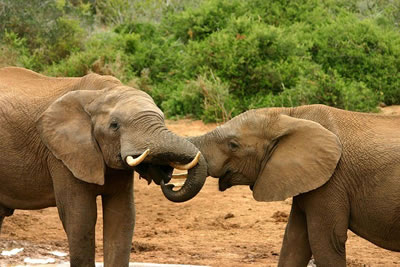Elephant Communication

Facts about creatures
- Home
- Animal Classification
- Animal Habitats
- Amphibians
- Arthropods
- Bats
- Birds
- Carnivorans
- Cetaceans
- Chordates
- Crustaceans
- Dinosaurs
- Diprotodonts
- Elephants
- Fish
- Golden Mole
- Insects
- Lagomorphs
- Mammals
- Mammal Teeth
- Marsupial Mole
- Metamorphosis
- Mollusks
- Primates
- Reptiles
- Rodents
- Ruminants
- Soricomorphans
- Tenrec
- Tetrapods
- Vertebrates
Elephant Communication
Elephants live in structured social groups, so the ability to communicate is very important to them.
They use sounds, smells, touches and gestures to communicate.
Sound
Elephants have at least 25 distinct calls.

When elephants wish to communicate over long distances, they send out low frequency rumbles, some of which are infrasonic – too low for human beings to hear.
These rumbles can travel through the air and through the ground for miles.When an elephant listens to these sounds, it faces the sources of the sound and lifts one front leg – possibly to focus the vibrations in the other legs.
Sometimes, it will lay its trunk, which is very sensitive to vibration, on the ground.
A 2000 study revealed that these low frequency vocalizations help elephants to recognize elephants from outside their group.
A study performed in 2003 showed that female elephants make these rumbling noises to let males know when they are close to ovulating.
In 2010, researchers at the San Diego Zoo discovered that pregnant females use low frequency rumbles to let the rest of their herd know when they are going to give birth.
This may encourage the other members of the herd to keep an eye out for predators while the newborn is vulnerable.
Many people are familiar with the trumpet, a sound that elephants make by blowing air through their nostrils. Elephants trumpet when they are very excited, for example, when they are startled, frightened or angry.
Elephants growl when they meet, as a form of greeting. A growl can escalate to a roar when an elephant is angry.
Smell
Elephant send out a variety of odor signals. Their breath, urine, and feces emit smells.
Secretions from their skin glands and reproductive tracts also produce odors.
Males and females smell each other’s urine to check their reproductive states.
An elephant has two temporal glands, each with an opening between the eye and the ear. Large amounts of a strong smelling liquid, known as temporin, are secreted through these openings when the element is excited. This may happen at a reunion with a family member, while mating or during a fight.
When males are in musth – a time when their testosterone levels are very high – they secrete temporin and dribble strong smelling urine. Females, which prefer to mate with males when they are in musth, can sense these odors.
Sometimes elephants will rub temporin. They may be leaving messages for other elephants that pass by later.
Elephants can use their sense of smell to tell different human beings from one another.
Touch
Elephants often communicate tactilely (via touch).
When two elephants pass each other, they will touch each other with their trunks.
Courting elephants intertwine their trunk.
Mother elephants will use their trunks to gently slap their children when they need to be disciplined.
Gesture
Elephants use had and trunk postures to communicate
Sometimes, they use these postures as threat displays.
When it is making a threat, an elephant will move forward toward its enemy while raising its ears and extending its trunk forward
An elephant approaching a smaller rival will roll up its trunk and then suddenly lash it forward.
An elephant shows that it is dominant by standing with its head held high and its ears spread wide.
To show that it is subordinate, an elephant will keep its head low and hold its ears back.